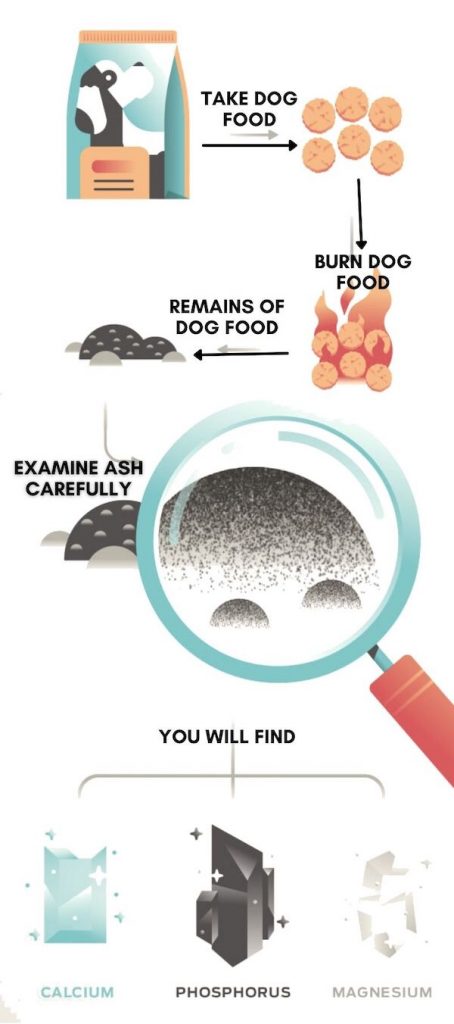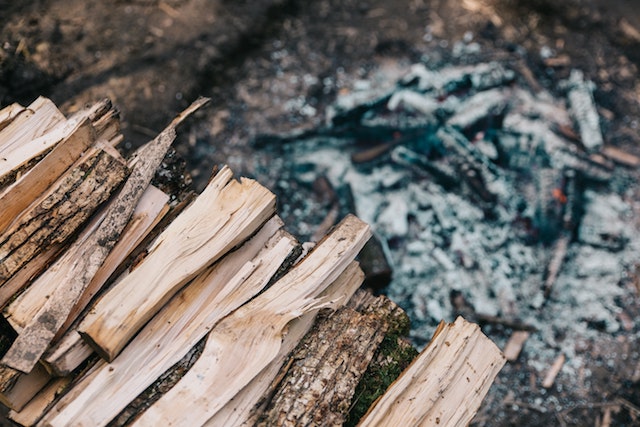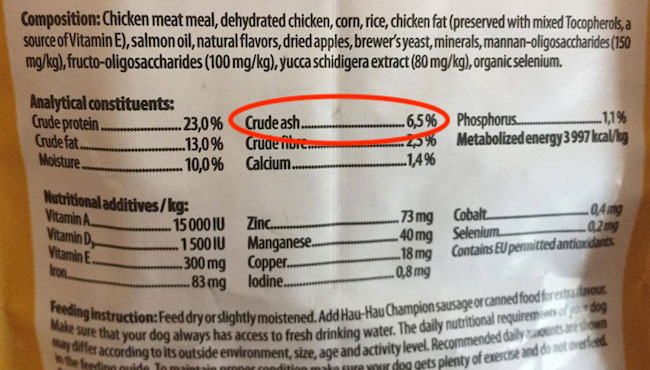Why do they print Ash on Dog Food Package and What is Ash in Dog Food? Let me tell you it is not what you think it is, read along to find out more. Most Importantly, It’s not a filler intentionally used to dilute a recipe.
Lets say, You stroll into a pet shop.
You are searching for some heavenly nourishment for your little furball.
Then run over the expression “Ash” and that without a doubt doesn’t sound appealing, on the contrary, it feels gross.
Indeed, reading the term ash on pet food can open ways to confusion and ambiguity.
By and large, the term ash on pet food is generally mixed up by fillers that are added to build up and dilute the food.
Ash otherwise called crude ash speaks to the mineral substance accessible in your canine food, as for the terminology, it is likely a result of the extras i.e. they are non-flammable components that are left when you burn nutrients.
One thing for sure is ash at moderate levels is something worth being thankful for.
Peruse along to discover what precisely ash is and how it can profit your little fuzzy fella.
Table of Contents
What Does Ash Mean in Dog Food?
No, no, it is not what you think it is, albeit the name might be confusing.
Yes, reading ash as content in dog food seems very discomforting as to why would someone use ash in food and why would someone eat it.

The term Ash or Crude Ash labeled on Dog Food packaging simply is a group of mineral content present in the food and is measured the same way as protein and fibers. It is mentioned as inorganic material or crude ash on the backside of the label. The included minerals are phosphorous, copper, calcium, selenium, and so forth.
If you take a full bag of dry pet food and burn it then most of the nutrients present will burn without a trace, however, what’s left will be the minerals.
They are the inorganic minerals or substances that are present in the food.
Therefore, when you find the term ash, crude ash, incinerated residue, inorganic substance it simply means those leftover minerals.
These minerals are necessary for dogs and so dog’s food cannot be made without ash.
The level of ash content should be adequate and it will be a deciding factor when it comes to the quality.
Bones in some diet also adds up to the level of ash content, as bones are known for containing a ton of minerals.
Ash levels are really important as you get a clear idea of how much minerals you want and whether they are in excess or not for your dog.
Fact | Corn gluten meal in dog meal is a by-product of processed corn. It’s an excellent source of protein and amino acids for your dog.
Why Ash is Used in Pet Foods?
Ash or otherwise known as the incinerated residue is also found in the Guaranteed Analysis label, it is also made from bones, scales, and shells of marine animals.
They are high in calcium and phosphorous which are beneficial for animals as well as for fishes.
Ash is never used as a single ingredient but it is recorded on the name as a pointer of mineral substance.
Minerals are another class of nutrients that is necessary for your pet’s body and health.
They must be incorporated to ensure a solid and healthy diet. Minerals such as calcium, magnesium, and phosphorous are great for animals’ body functioning and development.
So they are used in pet food to maintain the nutritional requirement of your pet.
As they are minerals their intake amount should be adequate and limited.
Your pet’s need for nutrients should be met by his daily diet.
But once the requirement is met there is no need to increase the levels of ash content.
Note: Read about what is venison meal in dog food here and find out why it is good in your dog’s food.
Importance of Ash in Dog Food

Nutrition is key for pets to grow and function properly.
For a healthy body, nutrients are the first thing to look for, and as mentioned before that minerals belong to nutrients that are necessary for your canines growth and healthy body.
Ash is the needed filler for dogs. They require about a minimum of 2% ash content in wet food to keep their nutritional requirements in check as well as improving body fluid.
As it contains phosphorous, calcium, and other trace minerals it also enhances the bone and teeth of your pup.
Ash content varies and depends on the product.
Generally, you will find that most of the commercial pet products have ash around 5 to 8% which is adequate for dry foods. So ash content anywhere between 5 to 7% is great but more than that is high.
It is important to note that higher amounts of ash content are not good for your dog’s body.
A lot of ash can be a problem as well, it could cause gastrointestinal issues and too much of one mineral can repress the take-up of another, either straightforwardly or by binding.
Not to mention, the excess of phosphorous can lead to several kidney problems.
Looking ash on the label should not be a matter of concern as it is required for your dog’s survival. Just make sure that it is taken in moderation and at adequate levels.
Note: Canola meal in dog food is an ingredient that remains after removing the oil from the seed. It has a great amount of protein, vitamins, and minerals with an excellent amino acid profile that helps dogs to build their muscles.
Is Low Ash Content Good?
Lower ash content is great and it typically means that the pet food has fewer fillers and high quality of food.
The more pertinent question is understanding how much mineral your dog requires and how much the food is offering.
This way you get the idea of how it is going to affect your dog and whether it is healthy or not.
Traditionally, wet foods come between 1 to 2% ash content while dry food comes between 5 to 8% and it has been observed up to 10%.
The percentages vary according to the product and ingredients used. Usually, fish and chicken meat will have less amount of ash content whilst red meat have higher content.
Mostly higher quality of meat will contain less amount of ash content as it contains less bone than other meats.
Generally, you’d have to include a low ash content food if you happen to have large breeds puppies or dogs with some urinary or kidney tract problems.
For large breed puppies, it is recommended to feed them a low ash content diet.
The main reason for this is as high ash content contains huge amounts of calcium and phosphorous.
And feeding them would result in unnecessary growth which may have a negative impact on their bones and joints.
Similarly, high traces of phosphorus can be the culprit in the formation of bladder stones or kidney problems.
So if your canine is suffering from any sorts of kidney problems then they are better off with high-ash content food.
Know More: Chicken Meal In Dog Food | Beef Meal In Dog Food | Lamb Meal In Dog Food
Is Ash in Dog Food Safe for Dogs?
If you find ash in your dog’s food label then there is no reason to worry about it is completely healthy and safe.
It denotes that your dog is getting the needed nutrition for better body development and functioning.
Just so you know, the main thing here is to understand the percentages and how much your pooch actually needs.
If you are looking for numbers then the food with ash content above 10% means that there are more filler and lower quality of meat which you should totally avoid.
With that being said, the best way to ensure that your puppy is getting the ideal amount of balanced ash content is by feeding higher quality meat as well as moisture in his/her diet.
This can be achieved by simply removing meat by-products and low quality of meat. Additionally, you can also feed them dehydrated, freeze-dried, canned, air-dried, and raw dog foods.
Do you know? Turkey meal and salmon meal in dog food are protein rich ingredients
Ingredients Labelled as Ash in Dog Food
Many state guidelines require pet food to ensure the rough rates of crude protein and fat as well as the greatest rates of moisture and crude fiber.
This is known as Guaranteed Analysis, the term crude represents the particular strategy for testing the item, not the nature of the supplement itself.

A few producers incorporate guarantees for different nutrients as well. The maximum percentage of ash is mostly guaranteed, for canine food the least levels of phosphorous, calcium, sodium, linoleic acid, zinc, iron, magnesium, sulfur, and iodine are found on certain items.
Do you know? There are many benefits of adding pork meal to dog food. Find all the benefits here.
FAQs
What is crude ash in dog food?
As per FDA, Incinerated residue or otherwise known as Ash or crude ash is just the indicator that shows the mineral content of your dog’s food. It represents minerals such as iron, phosphorous, magnesium, calcium, and so forth. It is also referred to as inorganic matter, so when you find crude ash mentioned on your pet food, it simply means the amount of minerals.
Is ash bad for dogs?
Ash is crucial for your little furry companion’s growth and body functioning as it contains necessary minerals. So it is good for your dog, but with that being said, make sure that your pup is receiving it in healthy amounts.
How to determine ash content in dog food?
If you are using a dog food that hasn’t mentioned the ash content then you can estimate the percentage of 2.5% for wet dog food and 8% for dry dog food, give or take a few percentages. Another way to find ash content can be by burning your canines food, which will burn the organic materials and leave behind the inorganic matter or also known as ash.
Is ash added to dog food is a single ingredient?
No, ash represents the mineral content as a whole, so ash is not a single ingredient, but it is an indicator that displays the mineral content of a particular food.
The Final Note
So now that you are acquainted with what ash is in dog food and its importance.
The next time you see the ash labeled on the dog food, you don’t have to worry.
You can take a sigh of relief as it is not some burned content of a tree. With that being said make sure to check out with your vet that if your pooch needs a high ash content or low ash content diet.
Ash is just the indicator of mineral contents available in your dog’s food and that is crucial for your dog’s growth. As long as you are taking and feeding your pup with moderate and adequate levels of ash content then there is no cause for concern.
Just a recaller, that 5 to 8% of ash content is healthy for your dog if you are feeding dry food, and as far as wet food is concerned then it is about 2% of ash content.
For balanced intake make sure to look for food with high-quality meat or if possible no meat meals and by-products.
Also Read:
References:
- Pet Food Labels – General [1]
- Pet Food Quality Assurance and Safety and Quality Assurance Survey [2]
- How to Understand a Dog or Cat Food Label [3]
- Evaluation of phosphorus, calcium, and magnesium content in commercially available foods formulated for healthy cats [4]
When things come crashing down, Tiffany comes to the rescue! As a veterinary medicine graduate, she is the brain behind the in-depth analysis of the products. As an avid dog lover, she is earnestly driven to find the finest options. Any article on DogNeedsBest that has to do anything with your pet’s health goes under scrutiny before getting published.


